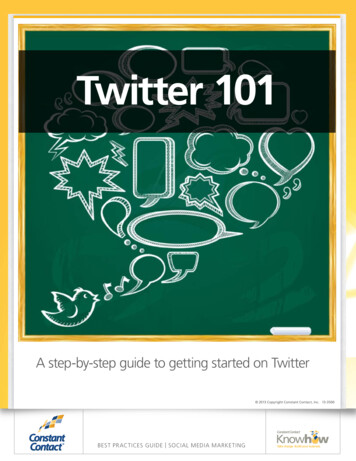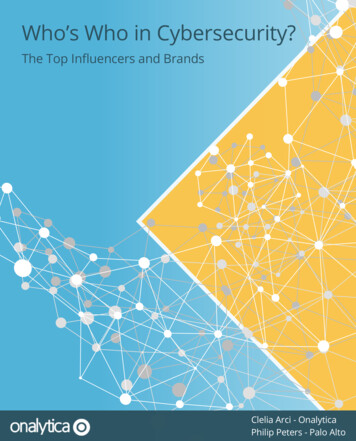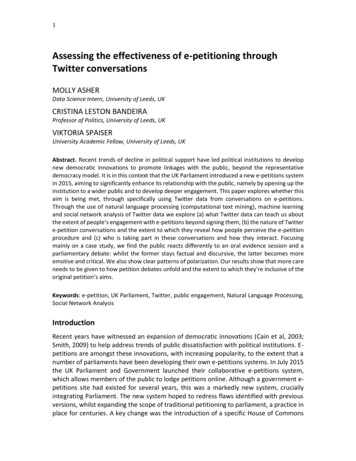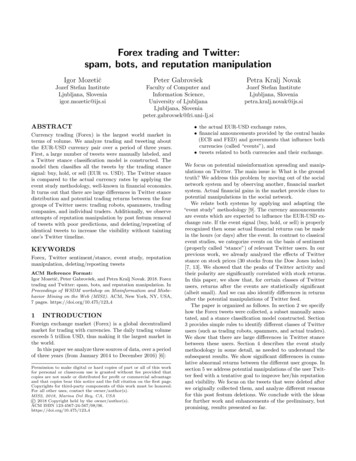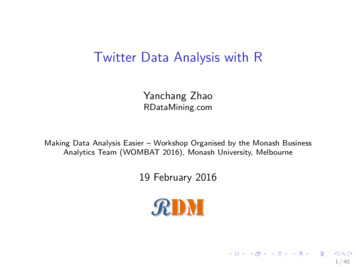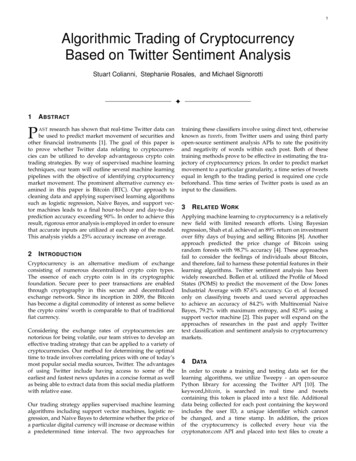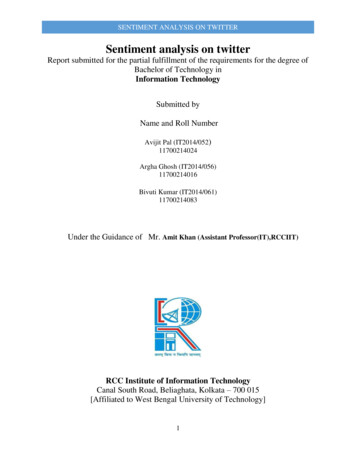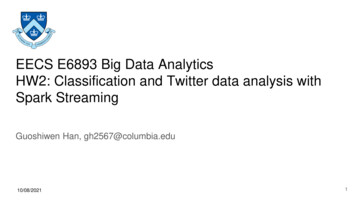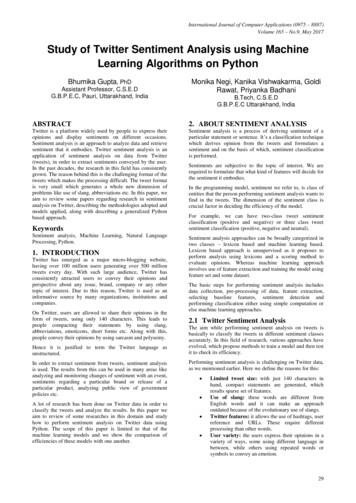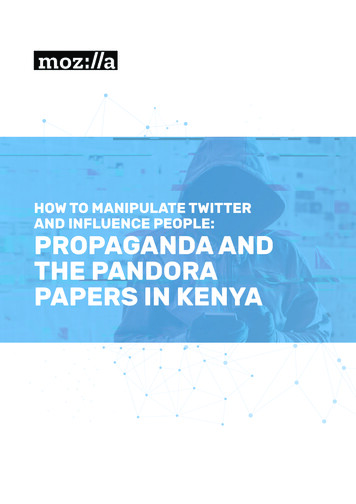
Transcription
HOW TO MANIPULATE TWITTERAND INFLUENCE PEOPLE:PROPAGANDA ANDTHE PANDORAPAPERS IN KENYA
Kenya’s disinformation industrytried to discredit the PandoraPapers to distort public opinionand protect the country’s elite.Investigating this activity showedus that its disinformation problemis much deeper than we thought.
CONTENTSfoundation.mozilla.orgExecutive Summary4Introduction5The strategy: Anti-Pandora Papers ‘astroturfing’6The context: Another entry in a flourishing industry12The Upshot: Twitter is complicit in harming democracy 14Acknowledgements163
foundation.mozilla.orgExecutive SummaryIn October 2021, the Pandora Papers were released to much ado, revealing several worldleaders’ secret offshore finances.Despite outgoing Kenyan President Uhuru Kenyatta’s inclusion in the Papers, legacymedia in Kenya provided only cursory coverage — creating a vacuum that social mediawas quick to fill. But as our past research has demonstrated, social media — andespecially Twitter — in Kenya is often leveraged to deceive and manipulate aroundpolitical issues, rather than foster open discussion. This phenomenon is fueled by thecountry’s flourishing disinformation industry: a shadowy and sophisticated network offake accounts, artificial hashtags, and well-paid disinformation influencers.Indeed, while public sentiment on Twitter was at first critical of Kenyatta, an alternativesentiment quickly emerged, supporting the president and his offshore accounts. Ourresearch shows that some of the tweets promoting this alternative sentiment wereoutright false. But other tweets were more nuanced: technically true, but clearlyinauthentic and coordinated to feign public support. In short: Kenyan Twitter is awashin Pandora Paper astroturfing.This research report unpacks how this astroturf campaign unfolded. It includesquantitative analysis using data from Twitter’s firehose. It also includes qualitativeinsight, like interviews with disinformation influencers. This report also grapples withthe bigger issues at play: How Kenya is home to a flourishing online disinformationindustry. How Twitter is unwilling — or unable — to address this problem. And how allthis threatens a democratic society in Kenya.4
foundation.mozilla.orgIntroductionOn 3rd October 2021, the International Consortium of Investigative Journalists (ICIJ)published the Pandora Papers, a massive investigation into how several public figuresuse offshore tax havens to hide assets worth billions of dollars. Almost immediately, thestory provoked a sharp reaction from the Kenyan public. This is because the family ofKenya’s outgoing president, Uhuru Kenyatta, was among those whose offshore financialengagements were exposed.Kenya has indeed had a long history of political families stashing massive amounts ofmoney abroad. This news, however, came at an especially charged time. Political tensionsin Kenya are at a high as the country nears the 2022 elections. The Pandora Papers alsoshowed up at a time when the country’s political scene was fresh from a heated debateon wealth declaration — one ignited by the government’s public revelation of the wealthbelonging to the neo-opposition leader, Kenyatta’s deputy, William Ruto.For many Kenyans, the Pandora Papers were the perfect summation of Uhuru Kenyatta’sregime: One that has been plagued by corruption scandals, soaring inequality, debtand skyrocketing commodity prices. Therefore, through social media, they let theirfrustrations be known loud and clear. Very quickly, the hashtag, #Pandorapapers, wenttrending on Twitter’s Kenyan ecosystem and remained a topic of conversation for theentirety of that week. However, peculiarly absent from the conversation within the first48 hours of the Pandora revelations, was coverage from local media outlets in Kenya.While the rest of the world and Kenyans dissected the implications of ICIJ’s revelations,Kenya’s mainstream media outlets were peculiarly silent. The silence didn’t go unnoticed.Alongside #Pandorapapers going trending, the term “Githeri Media” also surfaced onTwitter’s trending section. Kenyans started calling out the media demanding that theycover this issue.The temporary absence of critical mainstream media coverage of the Pandora Paperscreated an information vacuum that became fertile ground for a disinformationcampaign aiming to pacify the scandal following the leaks.With the government and thepresident under pressure, due to soaring online outrage, a counternarrative operationwas mounted — and found a strong ally in Twitter. Twitter’s trending algorithm amplifiedthese campaigns to millions of Kenyans who were using the platform to find informationabout the leaks and engage in discussions about them. As a result, a distortedperspective began to gain momentum — one where Kenyans appeared outraged not bythe Pandora Paper’s damning findings, but by their implication that Uhuru Kenyatta isguilty of wrongdoing.We therefore decided to follow up on our initial investigation into Kenya’s disinformationindustry by political actors. For this, we used data from Twitter’s firehose to dig intothe campaigns. We also once again managed to interview influencers who were paid toparticipate in the campaigns. Examining this activity provided us with further insightinto the goals of Kenya’s disinformation industry and just how long this industry hasexisted.5
foundation.mozilla.orgThe strategy:Anti-Pandora Papers ‘astroturfing’On 6th October, three days after Africa Uncensored (an independent journalism outlet inNairobi) and ICIJ released the Pandora Papers, the hashtag, #phonyleaks, was promotedby Twitter’s algorithms on the platform’s trending section. It would go on to featureprominently for 13 hours that day and even persist on the following day.In total, we examined 8,331 tweets produced during the campaign in the week of thePandora Papers’ release (3rd to 10th October 2021) from 1,935 participating accounts.Additionally, on October 8th, another counter-narrative effort got published on Twitter’strending section, #offshoreaccountfacts. We identified 3,870 tweets that were publishedunder it by 833 authors.6
foundation.mozilla.orgAn analysis of the content within the hashtags and the behavior of the accounts involvedshowed us that these assets that were indeed used for inauthentic behavior i.e.Several of the accounts that participated tweeted for days on end on nothing butpolitical hashtags. This is because these accounts are mostly used for the aim of gettingsomething to trend, almost every tweet they put out has a hashtag.Accounts within the campaigns also popped up in the database of inauthentic actorsthat we had identified after our initial investigation into Pro-BBI campaigns in May 2021.Many of the accounts we found have been tweeting pro-government propaganda. Webrought forward these accounts to Twitter earlier this year. Some were taken down andsome still stayed up.There was a heavy presence of the repetition of content within the hashtags. Theaccounts involved in the campaign repetitively used the same set of media assets intheir tweets or repeated the phrases within them. This wasn’t just on Twitter alone buthappened on Facebook too.7
foundation.mozilla.orgInauthentic name behavior was also present. Accounts mimicking celebrities were usedheavily by the influencers in classic bait and switch fashion. This is part of a formula whereindividuals use a widely familiar likeness and appealing content to grow audiences for anaccount. From there they then use it for the purposes of disinformation. It’s also knownas “Inauthentic Viral Spam.” The identities of Diana Marua and Lillian Ng’ang’a, both localcelebrities in Kenya, were used to spread disinformation for the #offshoreaccountfactscampaign. We reached out to them and both denied any association with the accountswe identified.8
foundation.mozilla.orgThe highest volume of content produced was also in the morning hours. We witnessedthis in our research on the BBI propaganda campaigns as well. According to RobinKiplagat, a disinformation researcher at Code for Africa, the time of the initial contentis vital: “Based on previous research we’ve conducted, our observation is that many ofthese hashtag campaigns are launched in early morning hours. Mostly between 6-7am.It’s easier to go trending at that time.” Furthermore, based on the timestamps tweetactivity would experience a sharp spike and then fizzle out soon after. For #Phonyleakshowever, the influencers claimed they would schedule additional tweets to run later sothat the hashtag could remain on the trending section.9
foundation.mozilla.orgBy examining the two hashtags and interviewing influencers involved in the campaign,we were able to understand its core message. The focus was on emphasizing that:-Uhuru Kenyatta was not a direct beneficiary of the accounts and he did not steal anyof the money that was highlighted.-The house the family bought through the offshore activity actually appreciated andtherefore it was a good investment.-The amount that was identified, 30 million, was very little compared to other bits ofwealth that the Kenyattas have in Kenya and therefore it isn’t a big deal.-Uhuru Kenyatta should be praised for the transparency he showed in his response tothe Pandora Papers.-It’s not illegal to have any money in offshore accounts as a public official and theyactually confer some advantages.Of key importance here was that many of these narratives were not explicitly lies. Thiswas political astroturfing that used a mix of propaganda and mal-information. It wasdesigned to fabricate consensus — specifically, the consensus that most Kenyanssupport Uhuru Kenyatta and distrust the Pandora Papers.However, some of the content within these campaigns was completely fabricated.Reginald Kadzutu, an economist with Amana Capital, found that his likeness had beenused to make it appear as if he had done an interview for the BBC. The image attributes aquote about the legalities of offshore accounts to him. Kadzutu and the BBC confirmedthat no such interview had happened. The image is fake.10
foundation.mozilla.orgBy focussing on these specific points their aim with the campaign was to dispossessthe Pandora Papers of their potential as a driver of change. They were meant to allowpoliticians to distract citizens from what was crucial. There are many people in Kenyawho are supporters of Uhuru Kenyatta and did not view the details within the PandoraPapers as a bad thing. This campaign was designed to appeal to them.Purity Mukami, who was one of the Kenyan reporters on the Pandora Papers who brokethe story in Kenya said: “I saw the campaigns against our story on Twitter and it wasvery clear that they were trying to discredit our work. It however, was very difficult forthem to do that because of how well researched our reporting was. The best they coulddo was try to pacify the story and lessen its impact. If you combine these campaignsalongside the kind of media coverage the Pandora Papers in Kenya got, you can seehow Kenyans may have gotten confused as to what the way forward should be. Kenyanswere denied the opportunity to discuss what makes holding government to account inthis country impossible. That is the goal these disinformation campaigns had and theywere successful.”“If you combine these campaigns alongside the kindof media coverage the Pandora Papers in Kenya got,you can see how Kenyans may have gotten confusedas to what the way forward should be.”—Purity Mukami, Kenyan journalist covering the Pandora Papers11
foundation.mozilla.orgThe context:Another entry in a flourishing industry.While the Pandora Papers revelations may be new, the existence of Kenya’s disinformationindustry is not. Our interviews with disinformation influencers about the PandoraPapers campaign and May’s BBI campaign provided a perspective on just how long thisactivity has been going on. One of the influencers we spoke to, via WhatsApp and onthe condition of anonymity, mentioned that they had been working on manufacturingTwitter trends for over five years: “Back then, I was in campus and it was an avenue forme to make money.” In that time, he also claimed to have participated in campaigns in2017 as a keyboard warrior for political parties. At that time, he claims influencers werepaid at a rate of around 25 per hashtag, with an average of 6 hashtags a day. For thepast five years, he has essentially been able to set up multiple sock puppet accounts andspread propaganda by manipulating Twitter’s trending algorithm. Twitter, meanwhile,has never caught him.Over the years, disinformation influencers also seem to have a formula for what it takesto get Twitter to publish their content on its trending section. The influencers we spoketo also gave us some insights as to what their perceived formula for getting the hashtagsto trend would be; “On a normal day, 500 tweets will do the magic. Keep in mind, thateven a retweet is a tweet. Within that mix you’ll also need around a 100 original tweetswith photos. The #phonyleaks campaign, because it came on a day where there was alot going on, needed about 2,000 tweets to trend.”Furthermore, the providers of these services confirmed to us that the service theyprovide is given to not only to political bidders, but just about anyone. Politicians andtheir operatives however, get charged much higher than others because of the riskinvolved. “Twitter and social media are just a game. It’s just business,” one influencersaid. What was even more astounding to us, was that the disinformation industry iscomplete with success stories of individuals who’ve “made it big.” “I know a guy whostarted doing this business when he was very broke and now the guy even got married,bought himself a car and his cheeks are very round. There’s money in this thing,” oneinfluencer told us.“I know a guy who started doing this business whenhe was very broke and now the guy even got married,bought himself a car and his cheeks are very round.There’s money in this thing.”—Disinformation influencer12
foundation.mozilla.orgWhat’s especially noteworthy is how this space operates more and more like amarketplace. Our interviews with the influencers also revealed that there are multipleinfluencer groups on WhatsApp which serve this exact function. Based on screenshotsthat we were able to review, here they exchange information about available politicalcampaigns and recruit each other.Influencers’ own politics rarely motivate or inform their participation. As Kenya’s rulingJubilee Party has fractured, so has influencer groupings within the disinformationapparatus of the party. “Many of the people participating in campaigns are aligningthemselves with where the money is.” Some influencers provide services across thedivide. “I have one set of accounts which I use when the Pro-Uhuru (pro-government)guys come calling and another set of accounts which I use when the Pro-Ruto guyscome calling (pro-opposition).”Influencers also mentioned that because of the tribal nature of Kenyan politics, thename of the pseudo accounts they set up are important. “Name matters because, fromthere, audiences can tell which tribe you’re in and assume which party that account isaligned to. It makes it more believable.” One of the influencers also similarly informed usthat “There are accounts I can’t use for certain jobs, I align myself with people based onthe audience they can reach.”“Name matters because, from there, audiences cantell which tribe you’re in and assume which party thataccount is aligned to. It makes it more believable.”—Disinformation influencer13
foundation.mozilla.orgThe Upshot:Twitter is complicit in harming democracyAs we mentioned in the last report, social media platforms, especially Twitter, matter.The public outcry that followed the publication of the Pandora Papers continues to showhow important these platforms are in terms of citizen accountability. This is especiallytrue in light of how critics view the framing of the revelations by legacy media. As anattempt to place it as an issue of legality instead of dignity and ethics.The situation that prevailed in Kenya after the Pandora Papers were published, is onethat does not bode well for its civic space. The delayed and watered down reaction ofKenyan media to the international controversy over the leaks, created an informationvacuum for propaganda campaigns to avidly scuttle credible reporting by smallerindependent outlets. Disinformation campaigns go hand in hand with the prevailingmedia environment of a society, just as they can do in the aftermath of natural disasters,where media vacuums leave voids that are easily filled with misinformation.These disinformation campaigns can fuel more than chaos and distrust online — theycan also preempt physical violence offline. One Kenyan activist who was targeted by thesame accounts involved in the Pandora Papers campaigns campaigns, Boniface Mwangi,had his house bombed just two days after the online attacks. Police are investigating thebombing and haven’t yet determined the culprit, although Mwangi speculated about apotential link: “They realised hashtags can’t scare me and they’re now using explosives,”he tweeted on October 20. As journalists and activists in the Philippines, Myanmar, andelsewhere in the world have revealed, disinformation and harassment campaigns onlinecan spiral into violence and tragedy offline.Meanwhile, once again, Twitter’s trending algorithm is a vital ingredient in this equation.We were able to identify a similar campaign running on Facebook but it is likely that theygot nowhere near the same viewership on Twitter. The problem is not that there’s badstuff on the internet. The problem is that some features of social networks are designedto make that bad stuff highly visible to many people. Manipulating Twitter’s trendingalgorithm, allows people lacking large organic followings to reach wider audiences withharmful messages. As one of the influencers we spoke to put it, “Twitter is easy.”“Twitter is easy.”—Disinformation influencerWe reached out to Twitter for comment on the activities we highlighted. After their owninternal investigation, they also took action on 230 accounts operating in the countrywhich they found had engaged in violation of their platform manipulation and spampolicy.14
foundation.mozilla.orgThrough a spokesperson they said: “Twitter’s top priority is keeping people safe, and weremain vigilant about coordinated activity on our service. Using both technology andhuman review, we proactively and routinely tackle attempts at platform manipulationand mitigate them at scale by actioning millions of accounts each week for violating ourpolicies in this area. We are constantly improving Twitter’s auto-detection technologyto catch accounts engaging in rule-violating behavior as soon as they pop up on theservice.”One of the things that we’re fast understanding is that disinformation is an industry.For platforms like Twitter, disinformation clearly won’t go away. There is a very strongdemand for successfully capturing public attention. Gaming Twitter’s algorithmprovides a sufficient prize for politicians seeking to harass activists and journalists.This report is not the first to highlight the harms that the platform’s features can cause.Fixing the problems with Twitter’s ecosystem will take more than just removing thetrending feature from the platform. For Kenyans, it means taking a deep look at howtheir politics has morphed in the digital age and seeing how to develop rules to governthis. For Twitter, it’s about being more transparent about their trust and safety efforts inAfrican countries, being consistent in enforcing their Terms of Service and paying moreattention to our context. Let’s start there first.15
foundation.mozilla.orgAcknowledgementsThis report was written by Mozilla Tech and Society Fellow, Odanga Madung.Additional reporting was done by Brian Obilo (Also a Mozilla Tech and Society fellow).The views of this paper do not reflect the views of Mozilla or the tech and SocietyFellowship program.We also want to thank Kevin Zawaki and Solana Larsen for their contributions inediting this report. The views in this paper do not necessarily reflect theirs, nor that oftheir employers.16
Thank Youfoundation.mozilla.org
especially Twitter — in Kenya is often leveraged to deceive and manipulate around political issues, rather than foster open discussion. This phenomenon is fueled by the country's flourishing disinformation industry: a shadowy and sophisticated network of fake accounts, artificial hashtags, and well-paid disinformation influencers.

